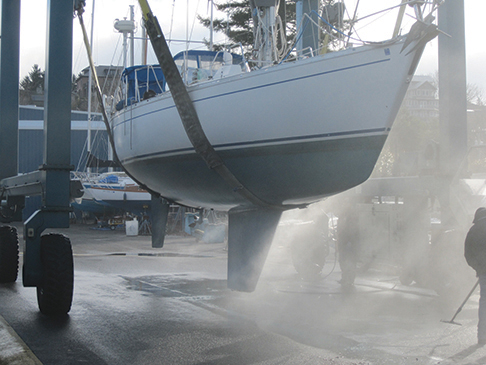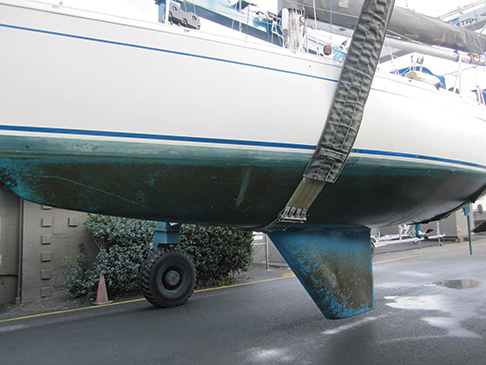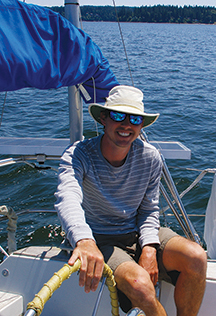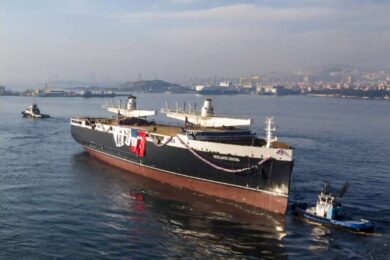With new laws coming that restrict toxins in bottom paints, researchers are exploring new technologies to keep our boats barnacle free (published April 2013)
In the United States and a few other countries, environmental concerns are beginning to shape public opinion and policy in ways that will soon have a direct effect on boat owners who rely on antifouling paints to keep their boats free from underwater growth. In 2011, Washington State passed a law banning the use of copper in antifouling coatings after the year 2018. California and other states are sure to follow this lead, which will eventually restrict the use of copper in paints just as tin was restricted two decades ago.
For the time being, copper based paints remain the standard while new copper free products are beginning to make inroads into the market. And, outside of the U.S., you can still find all types of antifouling paint, including those with tin biocides.
We asked six of our friends and regular contributors to give us their own personal experiences with antifouling paint and as you will see in the accompanying sidebars, the effectiveness of a wide variety of antifouling coatings is all over the map and depends upon the waters where a boat is sailed and many other factors.
ANTIFOULING BASICS
 With tin out of bounds for most of us in the U.S., unless you have an aluminum or steel hull, copper based paints are the first line of defense in the battle against barnacles, weed and slime. As a rule, the more copper in the paint, the more toxic it will be, and the more paint you apply, the longer the antifouling properties will last. There are four basic types of antifouling paints used by cruisers.
With tin out of bounds for most of us in the U.S., unless you have an aluminum or steel hull, copper based paints are the first line of defense in the battle against barnacles, weed and slime. As a rule, the more copper in the paint, the more toxic it will be, and the more paint you apply, the longer the antifouling properties will last. There are four basic types of antifouling paints used by cruisers.
Hard, modified epoxy paints dry into a permanent surface that is smooth and durable. The copper biocide leaches through the base paint when in contact with water and continues to do so at a decreasing rate until all of the copper is gone. High copper content is key to the effectiveness of modified epoxy paints. Such hard coatings are good on racing boats and those that will have their bottoms scrubbed regularly by a diver. The downside of modified epoxy paints lies in the thickness of the coating that remains on the bottom even after all of the copper has leached out. That means you need to sand the bottom thoroughly every time you apply a new coating to prevent a thick build up of paint.
Standard ablative coatings deliver the copper biocide to the surface by gradually dissolving or “ablating”. As a new layer of the coating is exposed, a fresh dose of copper goes to work preventing weed and growth from forming. Ablatives are good one season paints that do not build up layer upon layer and season upon season as epoxies do. However, the antifouling qualities in basic ablatives are lost once the boat has been hauled and stored out of the water. Also, ablatives can be applied over all other types of coatings so preparation is simply a matter of cleaning and light sanding before applying a new coat.
Similar to the basic ablatives are the copolymer ablatives that ablate at a steady rate and constantly expose new layers of biocide to the water. This class of paint works well on boats that are used a lot, especially in high growth areas. The more layers of paint you apply, the longer the toxic qualities will do their job defeating growth. It is common for skippers to apply three full coats when starting out with a copolymer ablative and those who will be more than a year between haul outs often use one color as a base and then cover that with several coats of another color so they will know when the top coats have almost ablated away. The toxic qualities of copolymer ablatives will survive a haul out and the paints can be applied over most other types of paint.
A true epoxy based coating that contains copper has shown promise to be the longest lasting antifouling paint on the market. The most popular brand is Coppercoat, which was developed in the 1980s and has been on the market since the early 1990s. The coating is a two-part epoxy that is filled with the maximum amount of copper allowed by the EPA. The coating has to be applied over a bare fiberglass bottom or over a hard epoxy barrier coat and will survive repeated haul outs. The copper biocide leaches slowly and steadily from the epoxy base and reportedly will last for up to 10 years. More expensive than even the best antifouling paints, Coppercoat makes a lot of sense if you plan to own and cruise your boat for many years.
ECO ALTERNATIVES
In the search for new types of antifouling coatings that are not harmful to the environment, scientists for the major paint companies and independent entrepreneurs have explored some very interesting alternatives.
White copper has been introduced to several brands of paints and requires roughly half as much copper biocide to do the job as the dark traditional copper that has been used for years. White copper also gives the brightest colors.
A new additive that shows promise is called ECONEA which uses the compound Tralopyril to prevent growth and slime. Interlux, Pettit and West Marine are all offering paints with ECONEA and the preliminary data from around the country indicate that these nontoxic, copper free products may well be the wave of the future.
ePaint has been on the market for 20 years and has no tin or copper in the blend. The paint’s biocide uses Zinc Omadine to combat slime and ePaint’s patented photo-active technology to ward off growth. The paint reacts to sunlight to form a layer of non-toxic chemicals that prevents barnacles and other hard shell growth from attaching to the hull. The coating goes on in thin layers so you will find that several coats work best.
A new product that also shows promise is a two-part epoxy coating called Eco-Clad that uses patented chemistry to create an extremely slippery biofilm that prevents any living organism from attaching itself to the boat. Hard and slippery, Eco-Clad is good for racing boats and those that will be used frequently. The coating is designed to be scrubbed from time to time and has shown the ability to provide antifouling protection for up to two years.

CHOICES
 There are many different antifouling coatings out there so it can be difficult to make the right choice for your budget, your boat and the areas you will be sailing. Certainly, the environmentally friendly coatings are looking better every year, which is a good thing since it is certain that we will have to use them in the future.
There are many different antifouling coatings out there so it can be difficult to make the right choice for your budget, your boat and the areas you will be sailing. Certainly, the environmentally friendly coatings are looking better every year, which is a good thing since it is certain that we will have to use them in the future.
The standard classics for cruisers still tend to be the high copper content copolymer ablatives and the modified epoxies that can be found all over the world and are supported by large companies. And, the now proven technology of Coppercoat may be one of the best long term investments you can make when considering non-traditional antifouling products.
John Neal
MahinaTiare III (Hallberg Rassy 46)
I used Pettit Trinidad and then Trinidad SR for many years. After about five months in tropical waters, it would need a quick overall gentle sponging. After six to seven months, that sponging would need to be every 10 days or so.
Four years ago it became unavailable in NZ & Australia, so I did a fair bit of research and chose Micron 66. I was hesitant going with an ablative paint since we consistently sail 10,000+ miles per year, and when we had earlier applied Hempels ablative paint in Sweden and then again in the Canaries, it ablated so well that we had little paint left after 5,000 miles.
This has not been a problem with Micron 66. After 10,000 miles it is in such good condition that the boatyard in Auckland says we should be able to go another season.
Daniel Collins
Aletheia (Allied Princess)
 I’ve used Coppercoat™ for over a year now on my boat and am quite happy with its performance so far. People report very long (many years) life with it, and I have not seen any reason to replace it so far. I only do a light scrubbing at the waterline every three or four months and I’m in a high growth area in the southeastern coastal U.S. It actually seems to get better with each scrubbing, which I’ve heard is also the case.
I’ve used Coppercoat™ for over a year now on my boat and am quite happy with its performance so far. People report very long (many years) life with it, and I have not seen any reason to replace it so far. I only do a light scrubbing at the waterline every three or four months and I’m in a high growth area in the southeastern coastal U.S. It actually seems to get better with each scrubbing, which I’ve heard is also the case.
Skip Pond
Saralane (C&C 40)
 I used to use the inexpensive WEST (CCP) paint that seemed to work well in Newport, RI for a season but not so well as we got to the Caribbean. I next bought copper based Blue Water Paint in Puerto Rico and after nine months we got a lot of slime and more than a few barnacles. This year we put on Blue Water Caribbean Gold (with tin). Sea Hawk 44 has a very strong following in the islands but Blue Water is less expensive (at $250/gal) and chemically very similar. In the five months it has been on (two months in St. Martin’s lagoon), the bottom is perfectly clean. Although most of us don’t like to admit it, outside the U.S. a lot of boat owners use the tin-based paints because they work—whether Sea Hawk or Blue Water.
I used to use the inexpensive WEST (CCP) paint that seemed to work well in Newport, RI for a season but not so well as we got to the Caribbean. I next bought copper based Blue Water Paint in Puerto Rico and after nine months we got a lot of slime and more than a few barnacles. This year we put on Blue Water Caribbean Gold (with tin). Sea Hawk 44 has a very strong following in the islands but Blue Water is less expensive (at $250/gal) and chemically very similar. In the five months it has been on (two months in St. Martin’s lagoon), the bottom is perfectly clean. Although most of us don’t like to admit it, outside the U.S. a lot of boat owners use the tin-based paints because they work—whether Sea Hawk or Blue Water.
Patrick Childress
Brick House (Valiant 40)
 We applied three layers of Super Ship Bottom, high copper content antifouling paint to the bottom of Brick House before sailing away from Rhode Island six years ago. In six months of cruising in the cool, nutrient rich coastal waters of the eastern U.S. and the Bahamas, a tenacious reddish moss seemed to grow roots into that soft ablative paint. Scrubbing with an abrasive pad was the only way to rid the hull of growth and despite the exposure of new antifouling, a few weeks later the growth returned. We were not alone; other cruisers we spoke with had similar problems with their different brands of top rated antifouling paints.
We applied three layers of Super Ship Bottom, high copper content antifouling paint to the bottom of Brick House before sailing away from Rhode Island six years ago. In six months of cruising in the cool, nutrient rich coastal waters of the eastern U.S. and the Bahamas, a tenacious reddish moss seemed to grow roots into that soft ablative paint. Scrubbing with an abrasive pad was the only way to rid the hull of growth and despite the exposure of new antifouling, a few weeks later the growth returned. We were not alone; other cruisers we spoke with had similar problems with their different brands of top rated antifouling paints.
Two years later, in Cartagena, Colombia, we applied three layers of Ameron, ABC#3 antifouling paint. Then, transiting to the tropical Pacific, that bottom paint seemed to work only a little better than the Super Ship Bottom. After two years, by the time we hauled in New Zealand, I had rubbed nearly all the ABC from the hull.
In New Zealand we applied three layers of Altex No.5 antifouling. This worked for a year then lost its antifouling abilities. The next effort will be with International, Interspeed 640, a semi-hard ablative. This is the same paint the U.S. Army uses on the hulls of its landing craft and high-speed ferries in the waters of the tropical Pacific.
From the results we have read in magazines, it seems paint test panels soaking in static coastal experiments may have little relevance to what actually happens on the hull of a long range cruising yacht.
Simon Day
Josephine (MiniTransat 6.5)
 The summer I sailed in the Bermuda One-Two, I used white ePaint ZO. It is a hard and fast bottom paint. Plus, it is environmentally friendly since it uses non-toxic chemicals to ward off growth instead of toxic metals such as copper or tin. It worked well all season in Newport, RI while I was using the boat regularly, but by the time I hauled her in the end of October—after letting her sit on her mooring in the harbor for more than a month—the bottom had some growth and slime.
The summer I sailed in the Bermuda One-Two, I used white ePaint ZO. It is a hard and fast bottom paint. Plus, it is environmentally friendly since it uses non-toxic chemicals to ward off growth instead of toxic metals such as copper or tin. It worked well all season in Newport, RI while I was using the boat regularly, but by the time I hauled her in the end of October—after letting her sit on her mooring in the harbor for more than a month—the bottom had some growth and slime.
The next spring, I rolled on two coats of Pettit Vivid White over everything and that also worked well all season. I scrubbed the bottom three times during the summer and it stayed pretty clean. The only real growth I got with the Pettit paint was surface slime.
Andrew Cross
Yahtzee (Grand Soleil 39)
 While instructing for Offshore Sailing School in Florida, we painted no fewer than 12 bottoms a year with Micron Extra and it was perfect for a warm water fleet. Like most paints in those waters though, diving to clean the bottoms every few months significantly extended the life of the paint and kept us sailing fast. On my own boat, a Grand Soleil 39, I have recently chosen to go with Sea Hawk’s Cutokote Biocide Plus based on the experience of friends who have used it and after talking with the guys at Seaview West Boatyard in Seattle who gave it very high marks for our local waters. It looks great in and out of the water and after returning from a few days of cruising, I am happy to report that it is much faster too!=
While instructing for Offshore Sailing School in Florida, we painted no fewer than 12 bottoms a year with Micron Extra and it was perfect for a warm water fleet. Like most paints in those waters though, diving to clean the bottoms every few months significantly extended the life of the paint and kept us sailing fast. On my own boat, a Grand Soleil 39, I have recently chosen to go with Sea Hawk’s Cutokote Biocide Plus based on the experience of friends who have used it and after talking with the guys at Seaview West Boatyard in Seattle who gave it very high marks for our local waters. It looks great in and out of the water and after returning from a few days of cruising, I am happy to report that it is much faster too!=

















